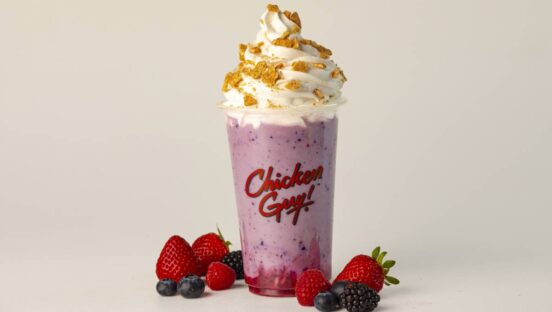Cutting calories, lowering fat content, and providing healthy, fresh ingredients have become increasingly commonplace in the limited-service industry over the past few years. But while U.S. quick serves have embraced the healthy lifestyle movement, some wonder if operators are still overlooking the need to offer allergy-friendly menu options.
Paul Antico, CEO of allergy-friendly restaurant database AllergyEats, says he had hoped new labeling laws and the growing desire for healthier options would force restaurants to look more closely at their ingredients and take allergies into consideration in new menu items. But he doesn’t think operators have done enough.
“Unfortunately, what I think we've seen more than anything is almost a crowding out,” Antico says. “What restaurants are saying is, ‘Look, we can only deal with one thing at a time. This year, we have to focus on the healthy eating, it's a hot trend, and we're being legislated on that. That's what we're focusing on now, and food allergies will just have to wait.’”
He says around four percent of U.S. residents have a food allergy and another one percent have Celiac disease, which means they are unable to process gluten. Some operators may consider these figures too insignificant to invest resources into allergy-friendly menu options, Antico says, or believe that creating such a menu is too time consuming and costly, with the benefits not outweighing the costs.
But he says providing an allergy-friendly menu can increase sales significantly. Each allergy-affected individual goes out to eat with an average of three other people, Antico says, which means that 5 percent of the population can translate into 15 to 20 percent of potential business won or lost.
“About 40 percent are more loyal to their favorite restaurant. The word of mouth and the sense of community between those with food allergies are very high,” Antico says. “It's critically important for them to share their thoughts, and they're extremely loyal. Once people with food allergies find a restaurant that can cater to them well, it relieves them. They go back fairly often.”
Soon, it may not just be economic incentives that encourage brands to offer allergy-friendly and gluten-free menu options. More consumers are demanding such items, going so far as legal action to satisfy their demands. Lesley University in Massachusetts, for example, lost a settlement to students with gluten sensitivities after requiring they buy a meal plan but not offering gluten-free options.
“I think people are asking questions now, instead of just accepting what restaurants are serving,” says Chuck Marble, CEO of Elevation Brands, a premium food provider. “Like we saw in the Lesley University lawsuit, they're demanding to have healthier alternatives as they choose to go out to eat at restaurants and other institutions.”
Of course, quick serves are not likely to be at the wrong end of a lawsuit for not offering allergy-friendly and gluten-free options. But they might be if allergy-friendly options are not executed properly.
John Lehr, CEO of Food Allergy Research & Education (FARE), says education and employee training are crucial in fashioning a restaurant that offers and perfectly executes allergy-friendly menu options.
“A trace amount of an allergen can cause anaphylaxis, a potentially life-threatening reaction,” Lehr says. “We have heard many stories from families who were told that a restaurant meal was safe when it actually was not safe.”
Antico also stresses the importance of thoroughly training employees and urges employers to develop additional training protocols beyond a simple video. When a person with allergies walks into a restaurant, he says, every employee should be able to inform him of the set procedure instituted to protect the guest from cross contamination.
“The problem is, without the staff being trained to understand the cross contamination, the menu options are worthless,” Antico says. “Anybody can throw a menu together with the right ingredients, but the problem happens in the back of the kitchen where we don't see it.”
Panera Bread is one of a handful of quick-service restaurants that make allergies a priority and communicates its efforts to customers.
“At Panera, we take the matter of allergens seriously in all our bakery-cafés,” says company spokesperson Linn Parish in an e-mail to QSR. “We have signs posted within our bakery-cafés requesting that customers ask for a complete list of ingredients if they suffer from allergens. Additionally, each café has a list of the ingredients contained in each product, which is available for customer review. Nutrition information and a list of ingredients and allergens for each product are also available on the online nutrition calculator on our website.”
While there may be work left to do in the industry to improve allergy-friendly options, the trend toward healthy eating has helped the gluten-free movement gain exposure. Gluten-free takeout orders have grown nearly 60 percent since April 2012, according to digital food ordering service GrubHub. This newfound demand has driven many quick-service restaurants to add suitable options to the menu.
“There is an increased focus on gluten free, because it is so hot right now,” Antico says. “Again, there's a big fad aspect, as well as the medical aspect.”
Antico encourages quick-service operators with the proper funds, infrastructure, and time to commit themselves to an allergy-friendly mindset.
“It's a great niche opportunity for those who are willing to accommodate,” he says. “The biggest barrier to a restaurant, whether it's independent or a chain, is commitment. It's the owners, the CEOs, the managers; if they make a commitment to becoming allergy friendly, it's not rocket science.”









